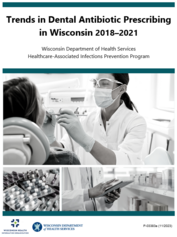|
This message is being sent to Tribal health directors, local public health officers, prescribers, dental providers, local public health department staff, infection preventionists, and local health department nurses.
|
To better understand the current state of dental antibiotic use, the Wisconsin Department of Health Services (DHS) Division of Public Health (DPH) Healthcare-Associated Infections (HAI) Prevention Program partnered with BSG Analytics, Delta Dental of Wisconsin, and the Wisconsin Health Information Organization (WHIO) to develop a series of dental antibiotic use measures.
These measures are shared in a new DHS report that describes trends in dental antibiotic use and identifies targets for improvement.
|
|
 |
Key findings
The number of antibiotic prescriptions per dental patient increased in Wisconsin from 2018 to 2021 (31.9 per 1,000 patients to 34.8 per 1,000 patients). When controlling for the number of dental visits, 2020 had the greatest rate of antibiotic prescribing per dental visit.
Nearly 21% of all antibiotic orders were for a second line agent, including clindamycin, macrolides, cephalosporins, and tetracyclines. This percentage is twice the estimated 10% of patients who report a penicillin allergy.
Recommendations
Based on the findings of this report, DHS recommends that dental clinics should focus antibiotic stewardship efforts on improved evaluation of reported penicillin allergies.
Next steps
The Wisconsin HAI Prevention Program and partners plan to update this report annually. Additionally, the Wisconsin HAI Prevention Program and partners are developing prescriber-level reports with built in antibiotic prescribing benchmarks to provide dental prescription data directly back to dentists.
|